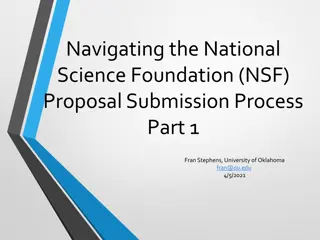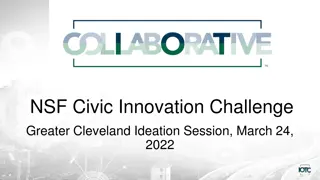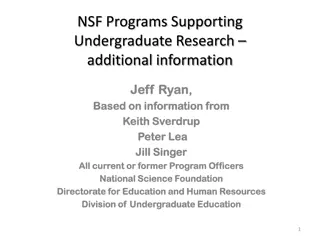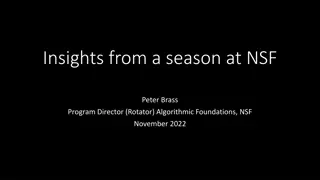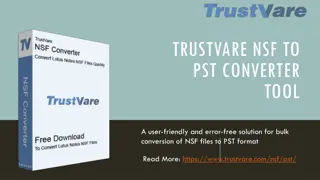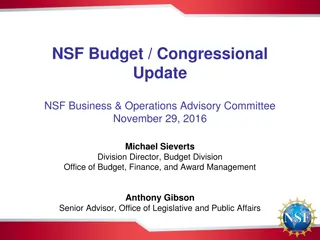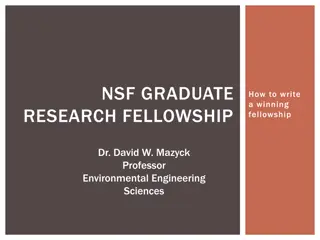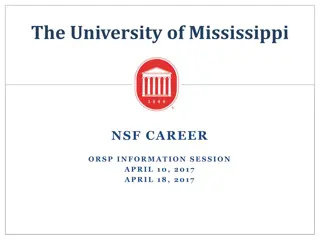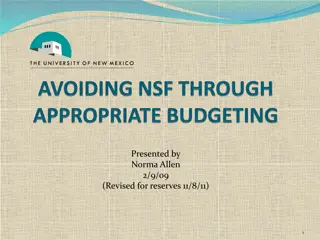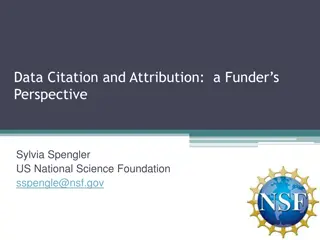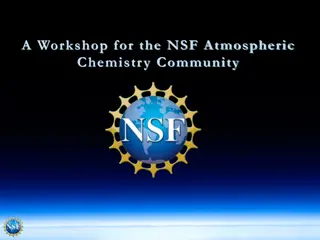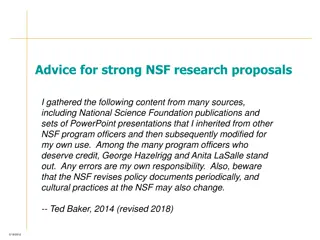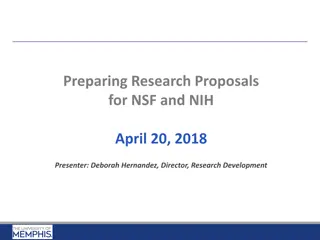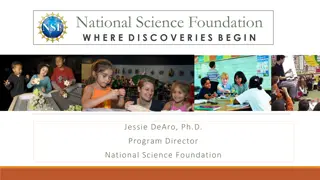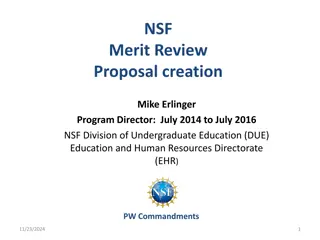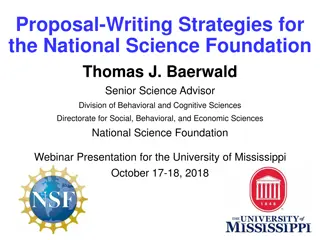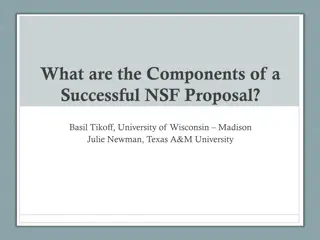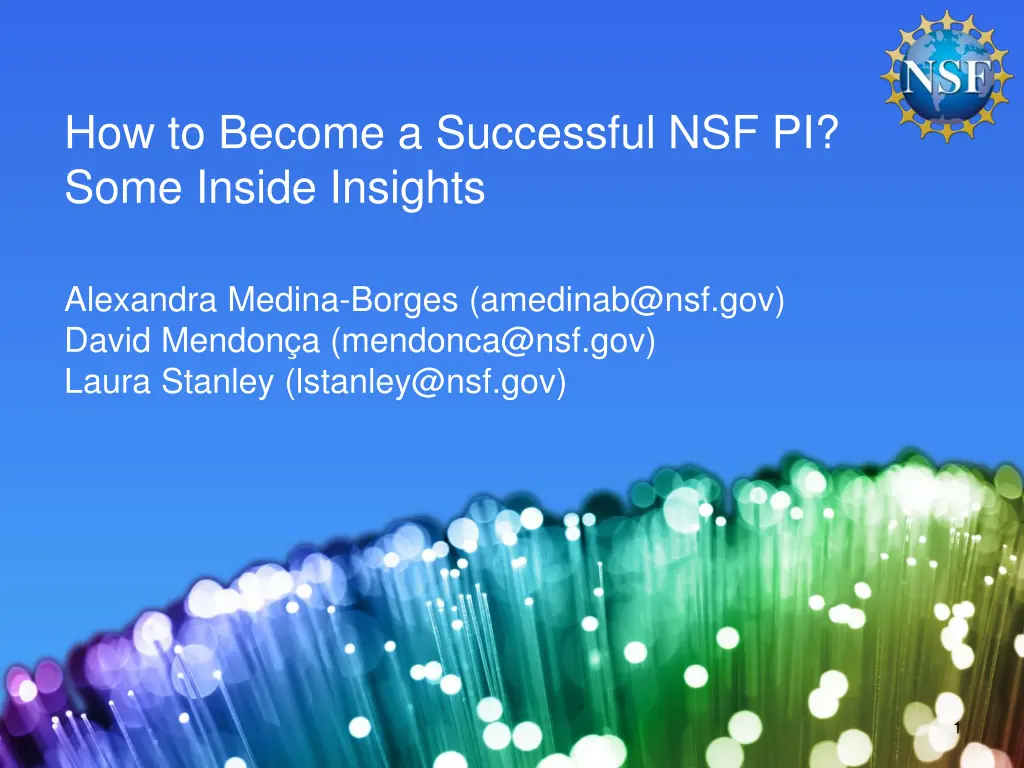
Insights on Becoming a Successful NSF PI
Gain valuable insights on how to become a successful NSF Principal Investigator (PI) from Alexandra Medina-Borges, David Mendonça, and Laura Stanley. Learn about NSF's mission, structure, proposal writing, and more.
Download Presentation

Please find below an Image/Link to download the presentation.
The content on the website is provided AS IS for your information and personal use only. It may not be sold, licensed, or shared on other websites without obtaining consent from the author. If you encounter any issues during the download, it is possible that the publisher has removed the file from their server.
You are allowed to download the files provided on this website for personal or commercial use, subject to the condition that they are used lawfully. All files are the property of their respective owners.
The content on the website is provided AS IS for your information and personal use only. It may not be sold, licensed, or shared on other websites without obtaining consent from the author.
E N D
Presentation Transcript
How to Become a Successful NSF PI? Some Inside Insights Alexandra Medina-Borges (amedinab@nsf.gov) David Mendon a (mendonca@nsf.gov) Laura Stanley (lstanley@nsf.gov) 1
Disclaimer and Acknowledgments Any opinions, findings, and conclusions or recommendations expressed in these slides are those of the authors/presenters and do not necessarily reflect the views of the National Science Foundation. Thanks to Jim Hendler for some tips and to George Hazelrigg for other material, available here: http://aries.imse.ksu.edu/nsf/NSF2014/Workshopdoc.htm 2
Agenda for Session 1. Overview of NSF (10m) 2. Division/Program Profiles (15m each) CISE/Cyber-human Systems (Laura Stanley) ENG/Smart Service Systems and Industrial Innovation and Partnerships (Alexandra Medina-Borges) ENG/Infrastructure Management and Extreme Events (David Mendon a) 3. Writing effective proposals (10m) 4. Questions (10m) 3
1. Overview of NSF Mission: To promote the progress of science; to advance the national health, prosperity, and welfare; to secure the national defense.... To find the right opportunity, learn about NSF structure, processes and personnel. 4
Structure Director Directorates Divisions Clusters Programs ENG has 5 divisions, including CMMI CMMI has 4 clusters and 17 programs Structure:Funding mapping is always evolving 5
Unsolicited Proposals Core funding instrument Submitted to a particular program Single or collaborative Average award size varies Success rate in ENG is ~14%
Solicited Proposals Submitted in response to specific initiatives Graduate Research Fellowship CAREER Engineering Research Center Others Can be managed by multiple divisions, programs, PDs You may have to modify your research goals a bit or take some liberties with stated program goals.
Systems View of Proposal Processing Proposal RFPs QC PI OK Revs&Recs Agency PM Revs& Decision Proposal& Instructions Panel Revs. Panel PD is an investor wants to diversify and strengthen program portfolio Peers
Review Criteria Intellectual Merit: New knowledge? Potentially transformative? Broader Impact: Benefit society? Promote education? Increase participation? For each Good Plan? Qualified Team? Adequate Resources? Track Record? Note: other solicitation-specific criteria may apply 9
Task of the Panel Panelists review proposals with respect to IM&BI criteria Panelists Roles: Lead (L): provides objective overview and leads discussion Scribe (S): summarizes discussion, prepares panel summary Reviewer (R): provides review of the proposal Typically, L/S/R all provide written reviews Panel concludes with a recommendation for each proposal May be that not everyone reviews every proposal but the panel s recommendation must be a collective one. 10
Summary Find the appropriate opportunity and person(s) o Divisions, Programs, PDs: http://nsf.gov o Award abstracts: http://nsf.gov o Opportunities: http://service.govdelivery.com o Your ecology: Sponsored Research Office, colleagues, publications Requirements vary, but all are important from fonts to teaming to timing of submission.
2. Program Profiles Cyber-human Systems Laura Stanley (CISE) Smart Service Systems and Industrial Innovation and Partnerships Alexandra Medina-Borges (ENG) Infrastructure Management and Extreme Events David Mendon a (ENG) 12
3. Writing Good Proposals I. II. Serving on NSF panels (AMB) III. Interacting with NSF program directors (AMB) Tips and pitfalls (DM, LS) 13
I. What Makes a Good Proposal?* 1. Respond to the call Ensure the fit is there Read and follow the requirements Program announcement and GPG; solicitation 2. A good grant tells a story What is yours? 3. Back up what you propose to do with what you ve already done 4. Show enthusiasm for your work *see Jim Hendler, How to get that first grant: A young scientist s guide to (AI) funding in America 14
What Makes a Good Proposal? 5. Know your audience NSF reviewers will want to know: What is the proposal about? How will you do it? (technical approach) Can you do it? (you/team and facilities) Is it worth doing? (Intellectual Merit and Broader Impacts) Rule of Thumb Someone on the panel must think yours is THE BEST! 15
What Makes a Good Proposal? 6. Readability is important Clarity, grammar, spelling, format all count Proofread, submit early and proofread again 7. Be visible! A reputation as someone who gets things done looks great on a review form 16
Common Pitfalls: Proposal Submitting good science to the wrong program Resubmitting without major revisions Submitting a project for an area in which you are not yet an expert (knowledge of state-of-the-art is essential) Not saying what is wrong with the state-of-the-art and why your research is needed Hiding the punch line on page 14 of 15 Not giving the proposal for a well-educated native English speaker to read (not necessary someone in your area of research) 17
More Pitfalls: Collaborations Not finding the most appropriate collaborations for interdisciplinary research Collaborations need to feel truthful but relevant (your best friend may not be the right one) Not asking your co-PI and partners to read the proposal and edit before submission Checking the box for the social and behavioral sciences instead of capitalizing on it 18
Common Pitfalls: Review Not writing to the panel Assume diverse areas of expertise and backgrounds Thinking that the panel will not check your references Thinking that the panel will not read in between the lines of budgets and letters (particularly partnership letters) Not publishing enough when you get an award: past performance is important 19
II. Serving on a Review Panel Why? Service to your community Learn the system Improve your future proposals avoid pitfalls! How to volunteer? Note and CV to your PD maybe once per year What to do when selected? Review instructions carefully Don t book your own travel . Arrive prepared and ready to engage 20
III. Should I Meet My Program Officer? Why? What do you intend to gain? Social visits don t help If you do Prepare by reviewing portfolio of current grants Provide advance written summary of your idea e.g., NSF format Project Summary Bring questions (e.g., fit, budget, review process) Listen Remember that PD is not the panel!
How Could a Meeting Help? Your program director can: Give advice on proposal submission Help you understand the review of a previous proposal Point you to resources you can use to help write a better proposal next time Give general guidance on good proposal writing Program officers look forward to constructive meetings with PIs
Summary There is no magic to writing a good proposal, it is a skill that can be learned. Learn from mentors Learn from your mistakes Learn from good examples Becoming familiar with the NSF system can help. Identify opportunities Serve on panels Interact with Program Officer 23
How to Become a Successful NSF PI? Some Inside Insights Alexandra Medina-Borges (amedinab@nsf.gov) David Mendon a (mendonca@nsf.gov) Laura Stanley (lstanley@nsf.gov) 24

